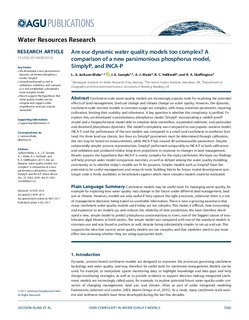| dc.contributor.author | Jackson-Blake, Leah Amber | |
| dc.contributor.author | Sample, James Edward | |
| dc.contributor.author | Wade, Andrew J. | |
| dc.contributor.author | Helliwell, Rachel C. | |
| dc.contributor.author | Skeffington, Richard A. | |
| dc.date.accessioned | 2018-04-19T07:25:16Z | |
| dc.date.available | 2018-04-19T07:25:16Z | |
| dc.date.created | 2018-01-10T15:59:09Z | |
| dc.date.issued | 2017 | |
| dc.identifier.citation | Water Resources Research. 2017, 53, 5382-5399. | nb_NO |
| dc.identifier.issn | 0043-1397 | |
| dc.identifier.uri | http://hdl.handle.net/11250/2494913 | |
| dc.description | This is an Published Version of an article published by American Geophysical Union in Water Resources Research, available online: https://sites.agu.org/ | nb_NO |
| dc.description.abstract | Catchment-scale water quality models are increasingly popular tools for exploring the potential effects of land management, land use change and climate change on water quality. However, the dynamic, catchment-scale nutrient models in common usage are complex, with many uncertain parameters requiring calibration, limiting their usability and robustness. A key question is whether this complexity is justified. To explore this, we developed a parsimonious phosphorus model, SimplyP, incorporating a rainfall-runoff model and a biogeochemical model able to simulate daily streamflow, suspended sediment, and particulate and dissolved phosphorus dynamics. The model's complexity was compared to one popular nutrient model, INCA-P, and the performance of the two models was compared in a small rural catchment in northeast Scotland. For three land use classes, less than six SimplyP parameters must be determined through calibration, the rest may be based on measurements, while INCA-P has around 40 unmeasurable parameters. Despite substantially simpler process-representation, SimplyP performed comparably to INCA-P in both calibration and validation and produced similar long-term projections in response to changes in land management. Results support the hypothesis that INCA-P is overly complex for the study catchment. We hope our findings will help prompt wider model comparison exercises, as well as debate among the water quality modeling community as to whether today's models are fit for purpose. Simpler models such as SimplyP have the potential to be useful management and research tools, building blocks for future model development (prototype code is freely available), or benchmarks against which more complex models could be evaluated. | nb_NO |
| dc.language.iso | eng | nb_NO |
| dc.publisher | American Geophysical Union | nb_NO |
| dc.title | Are our dynamic water quality models too complex? A comparison of a new parsimonious phosphorus model, SimplyP, and INCA-P | nb_NO |
| dc.type | Journal article | nb_NO |
| dc.type | Peer reviewed | nb_NO |
| dc.description.version | publishedVersion | nb_NO |
| dc.rights.holder | © 2017. American Geophysical Union. All Rights Reserved. | nb_NO |
| dc.source.pagenumber | 5382-5399 | nb_NO |
| dc.source.volume | 53 | nb_NO |
| dc.source.journal | Water Resources Research | nb_NO |
| dc.identifier.doi | 10.1002/2016WR020132 | |
| dc.identifier.cristin | 1540132 | |
| dc.relation.project | Norsk institutt for vannforskning: O-17044-B | nb_NO |
| dc.relation.project | Nordforsk: 74306 | nb_NO |
| cristin.unitcode | 7464,30,23,0 | |
| cristin.unitcode | 7464,20,18,0 | |
| cristin.unitname | Nedbørfeltprosesser | |
| cristin.unitname | Miljøinformatikk | |
| cristin.ispublished | true | |
| cristin.fulltext | original | |
| cristin.qualitycode | 1 | |
